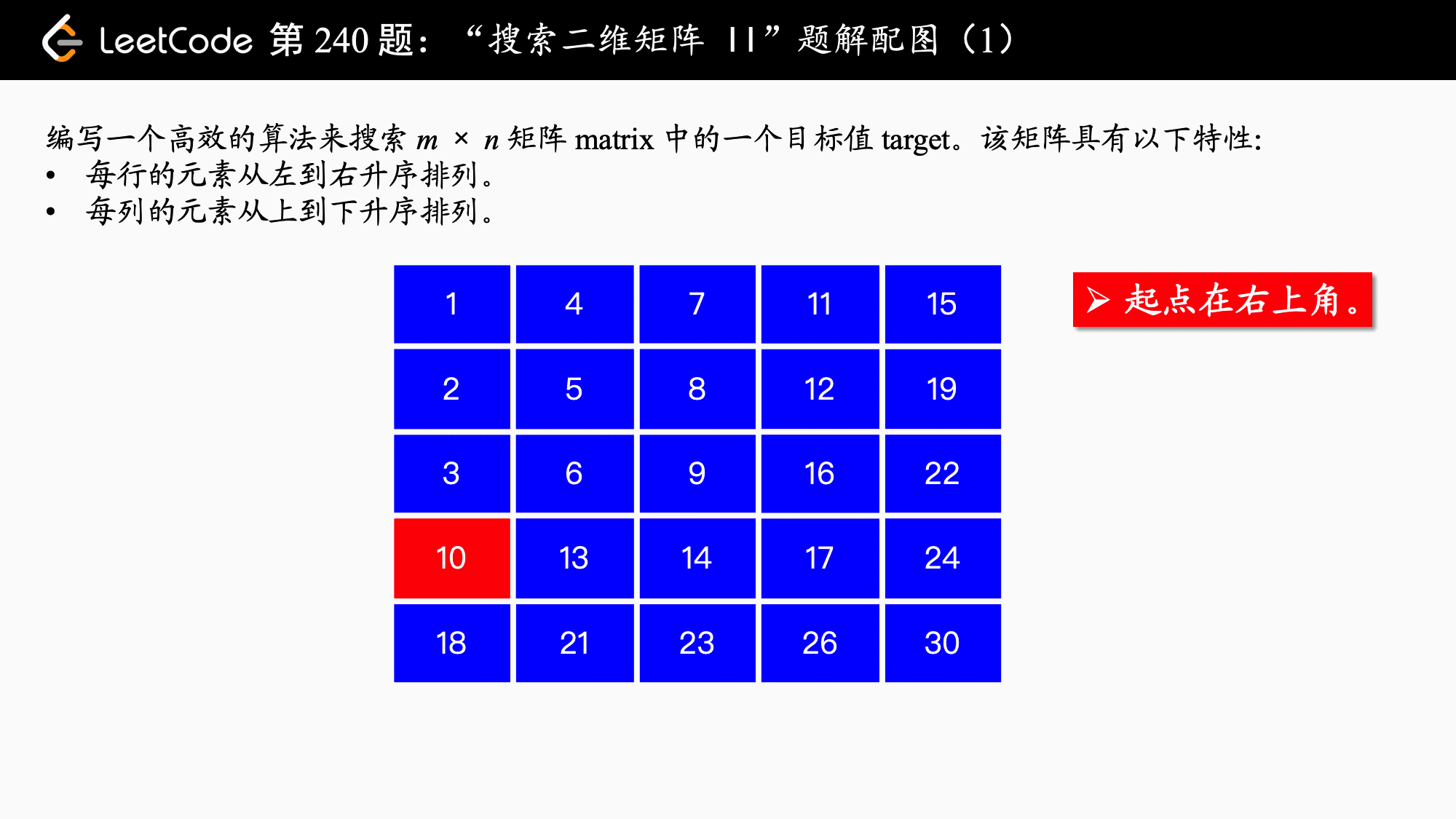LeetCode 第 240 题:“搜索二维矩阵 II”题解
题解地址:排除法(不是什么新方法,就是你们最常看到的那个解法,从右下角、左上角开始)(Python 代码、Java 代码)。
说明:文本首发在力扣的题解版块,更新也会在第 1 时间在上面的网站中更新,这篇文章只是上面的文章的一个快照,您可以点击上面的链接看到其他网友对本文的评论。
传送门:240. 搜索二维矩阵 II。
编写一个高效的算法来搜索 m x n 矩阵 matrix 中的一个目标值 target。该矩阵具有以下特性:
每行的元素从左到右升序排列。 每列的元素从上到下升序排列。 示例:
现有矩阵 matrix 如下:
[ [1, 4, 7, 11, 15], [2, 5, 8, 12, 19], [3, 6, 9, 16, 22], [10, 13, 14, 17, 24], [18, 21, 23, 26, 30] ] 给定 target = 5,返回 true。
给定 target = 20,返回 false。
来源:力扣(LeetCode) 链接:https://leetcode-cn.com/problems/search-a-2d-matrix-ii 著作权归领扣网络所有。商业转载请联系官方授权,非商业转载请注明出处。
排除法(不是什么新方法,就是你们最常看到的那个解法,从右下角、左上角开始)(Python 代码、Java 代码)
思路分析:
这道题比较容易想到的是还继续利用矩阵中的行和列有序的特性,使用二分查找法。思路不止一种,我也尝试写过,后来发现:编写二分查找法要考虑的边界问题比较多,如果对二分查找掌握得不熟练,很可能会出错。
下面介绍的这个方法,我认为是最优解,虽然它的时间复杂度并不是最优。
如果我们要用二分查找法,可以发现,如果一行的开头那个元素就比目标元素大,那么这一行的所有元素,以及行号大于这一行的元素都不在考虑的范围内。
我们首先尝试从左上角开始走,发现横着走数值增大,竖着走数值也增大,目标数值这在两个方向上都有可能存在。那如果我们从右上角或者左下角除法,找目标元素,那就不一样了,于是有了下面的“排除法”。
方法:排除法
1、如果选择左下角为起点
可以绘图如下:

总结出“搜索”的规律是:
如果当前数比目标元素小,当前列就不可能存在目标值,“指针”就向右移一格(纵坐标加 );
如果当前数比目标元素大,当前行就不可能存在目标值,“指针”就向上移一格(横坐标减 )。
在编码的过程中要注意数组下标越界的问题。
参考代码:
Python 代码:
class Solution:
def searchMatrix(self, matrix, target):
# 特判
rows = len(matrix)
if rows == 0:
return False
cols = len(matrix[0])
if cols == 0:
return False
# 起点:左下角
x = rows - 1
y = 0
# 不越界的条件是:行大于等于 0,列小于等于 cols - 1
while x >= 0 and y < cols:
if matrix[x][y] > target:
x -= 1
elif matrix[x][y] < target:
y += 1
else:
return True
return False
Java 代码:
public class Solution {
public boolean searchMatrix(int[][] matrix, int target) {
int rows = matrix.length;
if (rows == 0) {
return false;
}
int cols = matrix[0].length;
if (cols == 0) {
return false;
}
// 起点:左下角
int x = rows - 1;
int y = 0;
// 不越界的条件是:行大于等于 0,列小于等于 cols - 1
while (x >= 0 && y < cols) {
// 打开注释,可以用于调试的代码
// System.out.println("沿途走过的数字:" + matrix[x][y]);
if (matrix[x][y] > target) {
x--;
} else if (matrix[x][y] < target) {
y++;
} else {
return true;
}
}
return false;
}
public static void main(String[] args) {
int[][] matrix = {
{1, 4, 7, 11, 15},
{2, 5, 8, 12, 19},
{3, 6, 9, 16, 22},
{10, 13, 14, 17, 24},
{18, 21, 23, 26, 30}
};
int target = 12;
Solution solution = new Solution();
boolean searchMatrix = solution3.searchMatrix(matrix, target);
System.out.println(searchMatrix);
}
}
复杂度分析:
- 时间复杂度:, 是这个矩阵的行数, 是这个矩阵的列数,我们看到,这种算法是“不回头”的,至多走 步就能搜索到目标数值,或者判定目标数值在矩阵中不存子啊。
- 空间复杂度:O(1),算法使用了常数个变量。
2、如果选择右上角为起点
可以绘图如下:

总结出“搜索”的规律是:
如果当前数比目标元素大,当前列就不可能存在目标值,“指针”就向左移一格(纵坐标减 );
如果当前数比目标元素小,当前行就不可能存在目标值,“指针”就向下移一格(横坐标加 )。
在编码的过程中同样要注意数组下标越界的问题。
参考代码:
class Solution:
def searchMatrix(self, matrix, target):
# 特判
rows = len(matrix)
if rows == 0:
return False
cols = len(matrix[0])
if cols == 0:
return False
# 起点:右上
x = 0
y = cols -1
# 不越界的条件是:行小于等于 rows - 1,列大于等于 0
while x < rows and y >= 0:
if matrix[x][y] > target:
y -= 1
elif matrix[x][y] < target:
x += 1
else:
return True
return False
public class Solution {
public boolean searchMatrix(int[][] matrix, int target) {
// 特判
int rows = matrix.length;
if (rows == 0) {
return false;
}
int cols = matrix[0].length;
if (cols == 0) {
return false;
}
// 起点:右上角
int x = 0;
int y = cols - 1;
// 不越界的条件是:行小于等于 rows - 1,列大于等于 0
while (x < rows && y >= 0) {
// 打开注释,可以用于调试的代码
// System.out.println("沿途走过的数字:" + matrix[x][y]);
if (matrix[x][y] > target) {
y--;
} else if (matrix[x][y] < target) {
x++;
} else {
return true;
}
}
return false;
}
public static void main(String[] args) {
int[][] matrix = {
{1, 4, 7, 11, 15},
{2, 5, 8, 12, 19},
{3, 6, 9, 16, 22},
{10, 13, 14, 17, 24},
{18, 21, 23, 26, 30}
};
int target = 10;
Solution solution = new Solution();
boolean searchMatrix = solution2.searchMatrix(matrix, target);
System.out.println(searchMatrix);
}
}
复杂度分析:
(同上)。
说明:这个搜索的过程也可以使用二分查找法加快,时间复杂度收缩到 ,但是在编码的时候会稍显麻烦,还要考虑一些边界条件,我就不展示自己写的又臭又长的代码了。如果大家有更优雅的写法,欢迎分享出来。